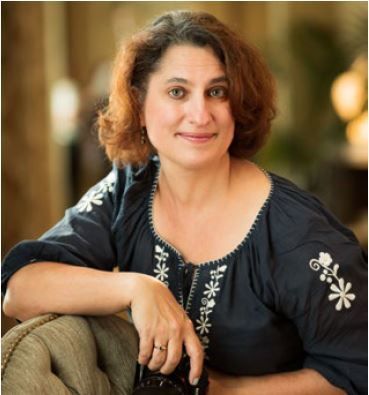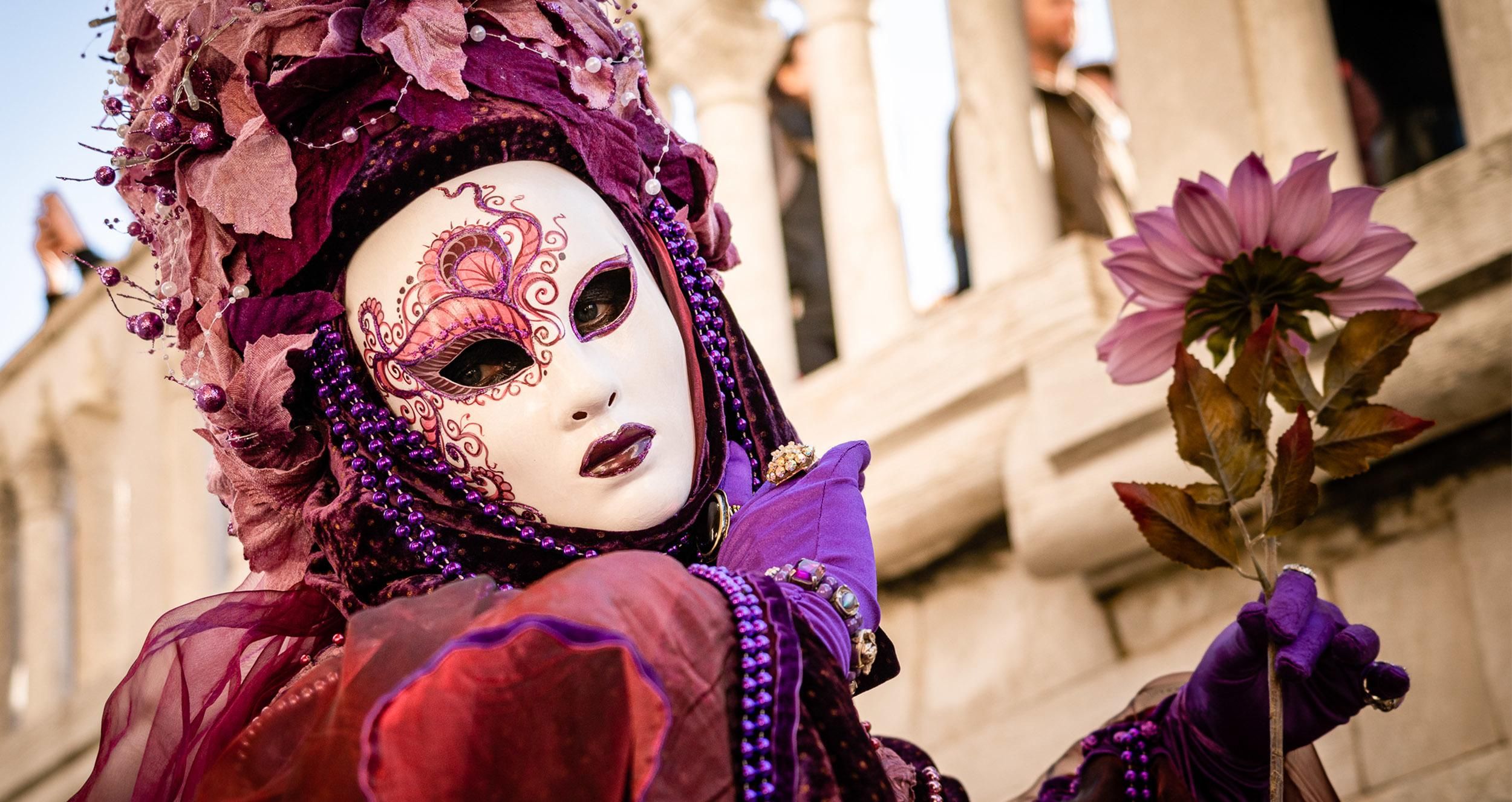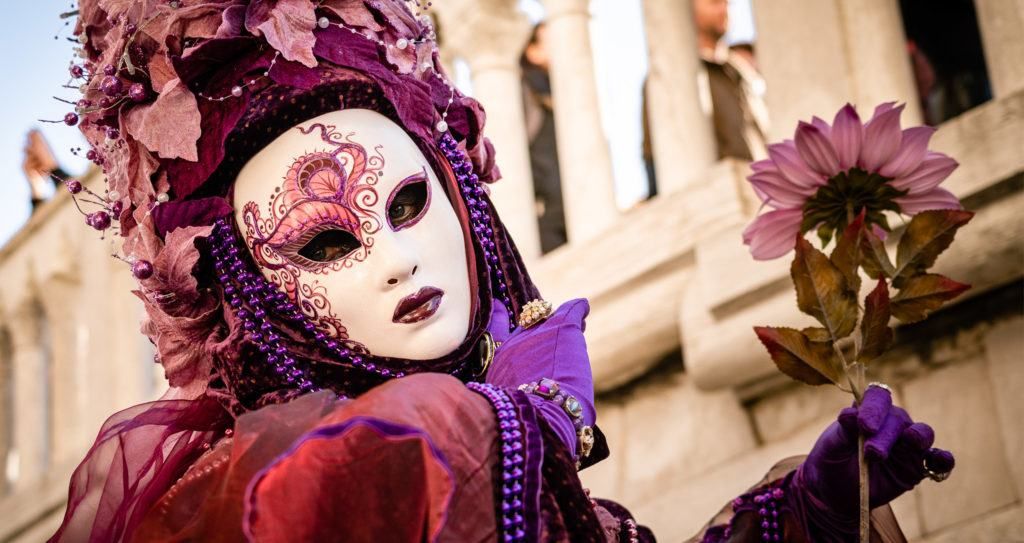Carnival is an annual pre-Easter celebration. The most famous are in Rio de Janeiro, Brazil; New Orleans (Mardi Gras), Louisiana; and Venice, Italy. In each culture, Carnival has a different look and unique traditions.
The Venice Carnival (Carnevale di Venezia) is best known for elaborate masked costumes and medieval traditions. There is something special about turning a corner and encountering people dressed as Mozart or Marie Antoinette. History comes alive and walks again on the city streets.
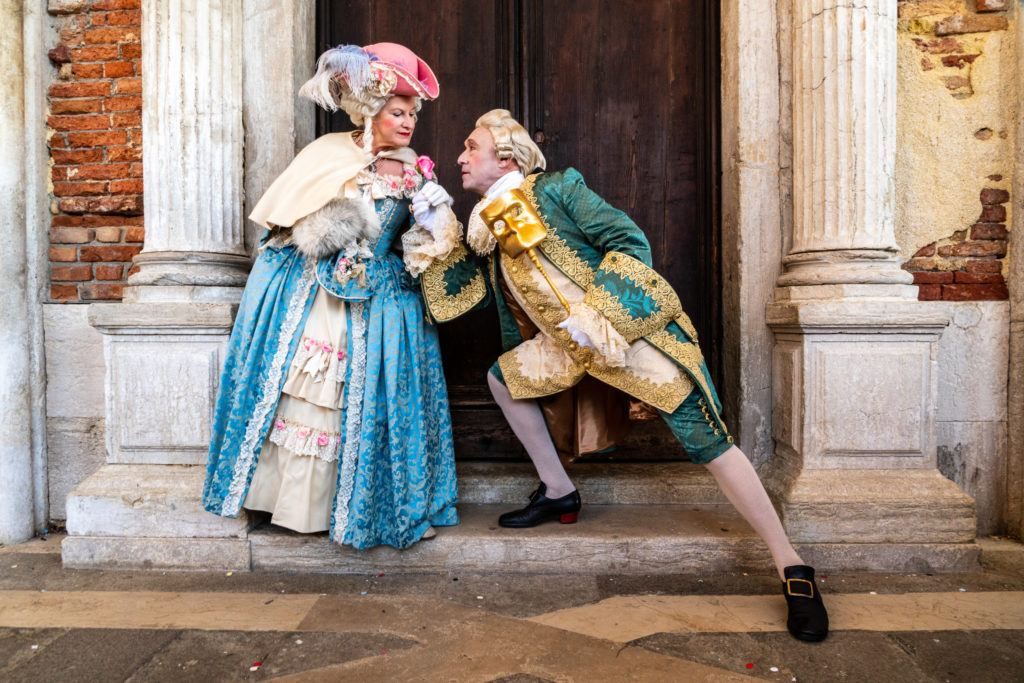
People from all over the world descend to Venice to walk the streets of the ancient city in period costumes. Photograph by Jenn Mishra
In this guide, I’ll give you the inside scoop on how to create iconic photos of Venice’s famous carnival. We’ll cover the following:
- Introduction to the Carnival of Venice
- Masks and costumes
- Know where to go
- Interacting with the costumed models
- Surviving group photoshoots
- Posing the models
- Photographing details and context
- Private photoshoots
- Camera equipment
Recommended Reading: If you’d like to learn how to create amazing portraits, grab a copy of Photzy’s premium guide: The Art of Portrait Photography.
Before we start, I need to say something about the Covid-19 pandemic.
COVID-19 Disclaimer:
I experienced the Venice Carnival before the Covid-19 pandemic. In fact, I was photographing in Venice in 2020 when the Italian outbreak started. The outbreak led to the cancellation of the last few days of Carnival. It is unclear what the festival will look like in the years following the pandemic. The festivities may be scaled down and enter into the country and the city may be restricted.
Introduction to the Carnival of Venice
Carnival is scheduled based on the Easter calendar. The last day is always Shrove Tuesday, the day before Lent begins. This means that Carnival dates change each year. The Carnival of Venice is just over two weeks long. The last eight or nine days are the most eventful and most crowded, as more revelers arrive in the city.
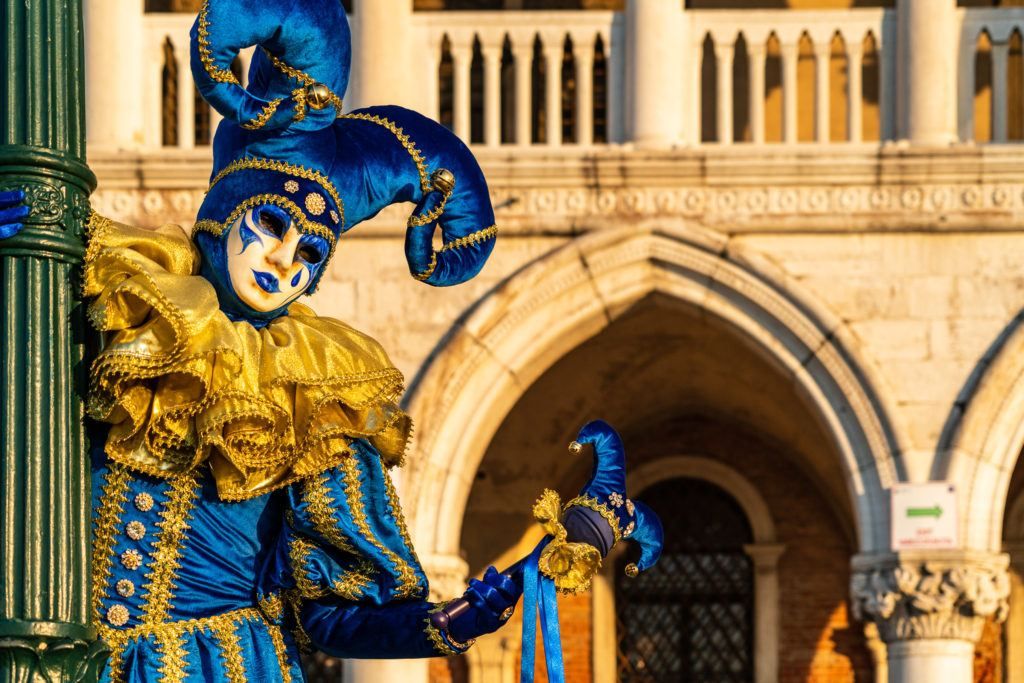
Hang out in San Marco plaza and Carnival will come to you. This jester poses on a lamp post. Photograph by Jenn Mishra
It’s difficult to boil down all the events happening during Carnival. There are parades, masked balls, and light entertainment all over the city. But Piazza San Marco (St. Mark’s Square) is the epicenter of it all.
You don’t need a press pass to photograph events. But official photographers usually have access to prime vantage points.
In general, events are crowded. You will need to arrive early to get unobstructed views. It’s not uncommon for photographers to wait three or four hours (or more!) for an event to start. If it’s your first time at Carnival, arrive extra early and scout the location. Ask the locals about good views. Sometimes they’ll give you a good tip.
For some events, the city enforces an elaborate contraflow system through the narrow streets. You will only be able to enter and leave the area via certain streets. It’s important to do a bit of research in advance or you may find access blocked.
In general, events are crowded. You will need to arrive early to get unobstructed views.
Carnival opens with a series of water parades. The night water parade is usually held on the first Saturday of Carnival. It is a unique spectacle often missed by visitors who come later to Carnival. Crowds line either side of the Rio Cannaregio and across the bridges.
On Sunday, a costumed boat race, the Punta della Dogana, begins at Santa Maria della Salute (Salute). The costumes are fun and colorful. The boats race up the Grand Canal and end on the Rio Cannaregio where there is a street festival.
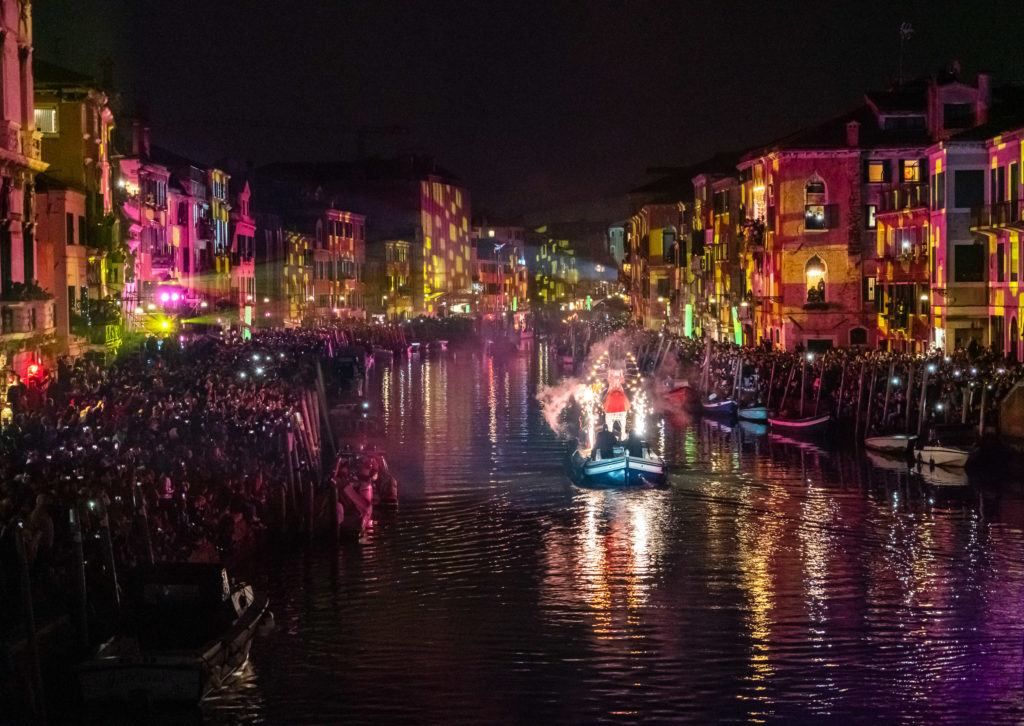
Night water parade along the Rio Cannaregio to open Carnival festivities. Photograph by Jenn Mishra
A large stage is set up in San Marco during Carnival. This becomes the center for events like dancing, costume competitions, light shows, and other spectacles. The events go well into the evening. You can easily spend days taking street photographs in San Marco.
Carnival begins in earnest with the Flight of the Angel. On the middle Sunday, an angel flies (on a wire) from the campanile and descends 300 feet to the stage in San Marco. Plan your spot by taking into account the sun’s direction.
Official and private masquerade balls are held at hotels and other amazing venues. These are often major social events. Tickets must be purchased in advance and tend to be pricey. People attending often work with costume designers in preparation for the event. But you don’t need a ticket to photograph outside the venue. Wait for an opportunity to photograph guests as they arrive. They are usually more than happy to show off their period couture.
The official festivities are only the tip of the iceberg. The entire city of Venice is the stage for Carnival. Throughout Carnival, masked participants glide through the streets with elaborate masks and costumes.
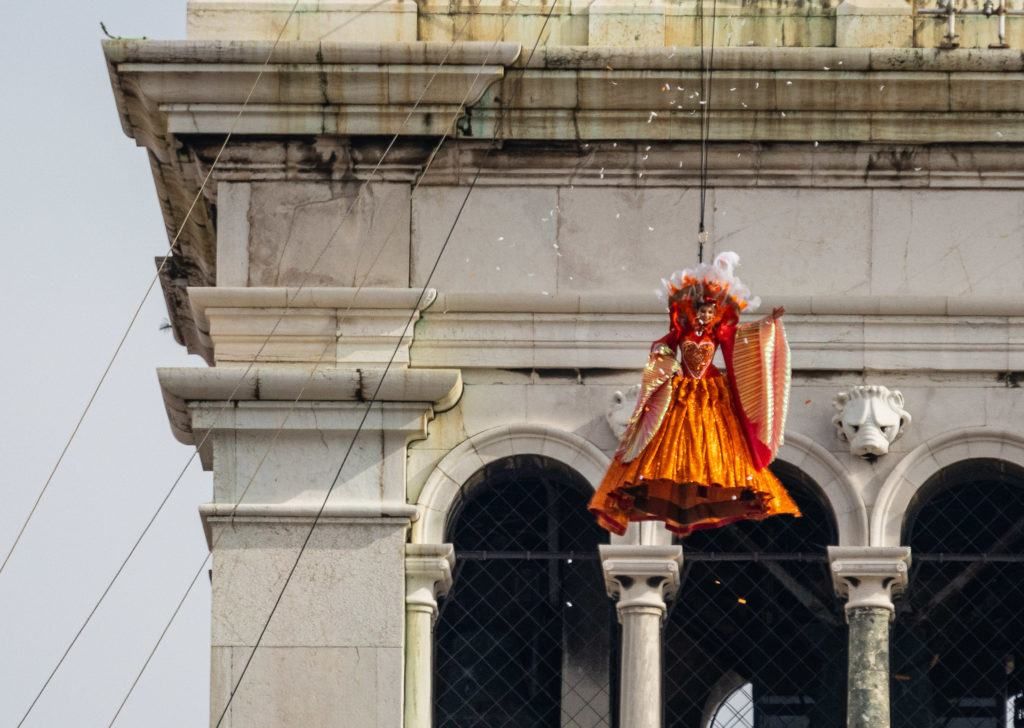
I photographed the Flight of the Angel from the rooftop café of my nearby hotel. Photograph by Jenn Mishra
Masks and Costumes
There is no particular dress code for Carnival. Participants can choose to dress in costume or not as they wish. Some dress in fanciful, funny, or cute costumes. Many wear elaborately detailed period costumes complete with wigs and headdresses. Others buy an inexpensive mask at a street vendor to join in the fun.
Venice Carnival has a dedicated following. Many of the costumed participants attend every year. They’ve devoted many hours and thousands of dollars to produce their costumes. They come to Venice to be a part of the experience. Most of the regulars arrive by the middle weekend. But there will be a few costumes floating through the city the week before.
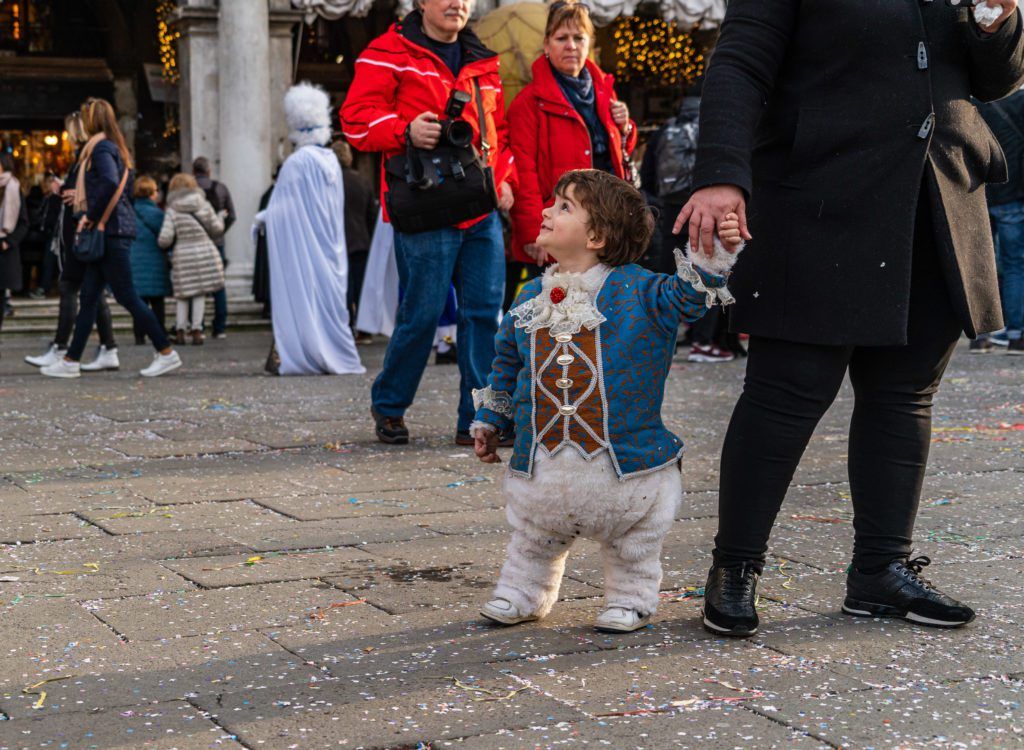
This child is amazed at the spectacle as he waits for the costume competition to begin in San Marco. Photograph by Jenn Mishra
Know Where to Go
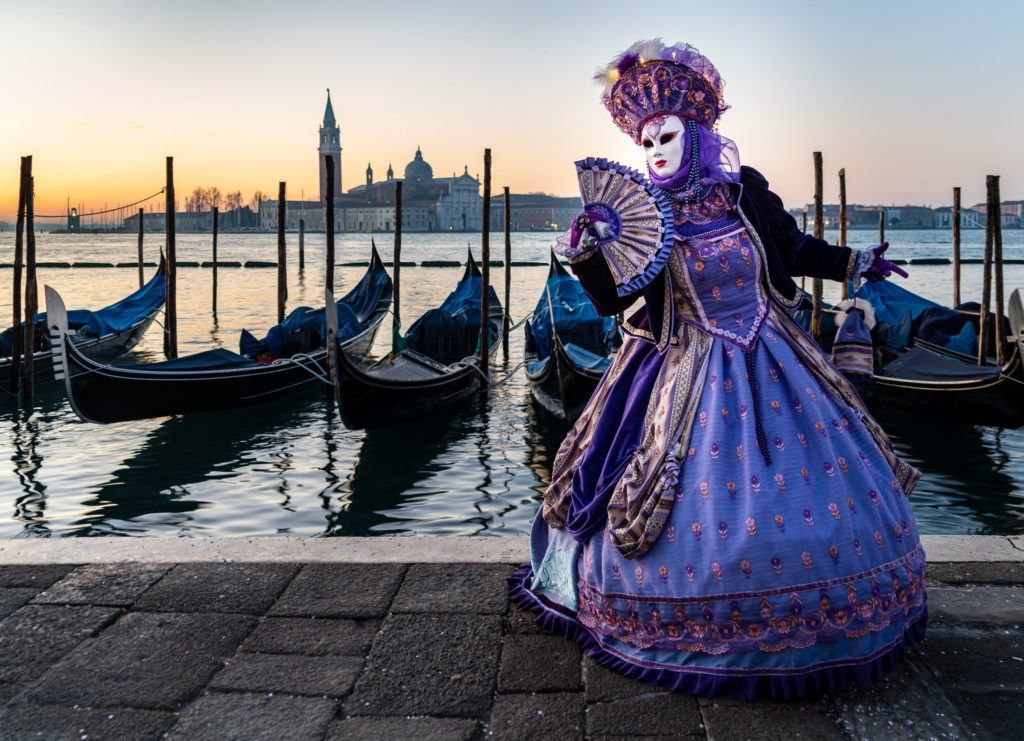
Mornings in San Marco take advantage of small tourist crowds and iconic backgrounds like the Grand Canal. Photograph by Jenn Mishra
San Marco is a popular place to photograph first thing in the morning, even before the sun rises. If you think the costumes are grand by daylight, wait until you see them light up! Photographers and models meet in the pre-dawn hour to take advantage of the light and colored sky. Backgrounds include the Basilica, the Doge’s Palace, and the Grand Canal.
There are events where masked models and photographers gather. These aren’t secret, but also not generally advertised to the tourist population at large.
Evening photoshoots move to San Giorgio Maggiore, an island across from San Marco. This island helps separate the models from the growing crowds. San Marco and Salute (Santa Maria della Salute) serve as backgrounds.
During the day, models rest and change costumes, but there are always a few floating around the city. Photoshoots move to less populated areas of the city, relatively speaking. A popular spot is the piazza in front of Chiesa di San Zaccaria.
For the models and returning photographers, Carnival is akin to an annual convention. They schedule informal meetings away from the Carnival crowds. Generally, they meet one day at Arsenale della Biennale di Venezia, one day on the island of Burano, and have a group photoshoot at Salute.
Recommended Reading: If you’d like to learn how to create amazing portraits, grab a copy of Photzy’s premium guide: The Art of Portrait Photography.
Don’t be shy about approaching anyone in elaborate costume and asking for a photo. Most are used to being stopped by tourists wanting selfies and will gladly pose for as many photos as they can. If they have to be somewhere, they will move when they need to.
When photographed in public, models don’t expect to be paid or tipped. They are having fun and experiencing Carnival. Having their photos taken by tourists and photographers is part of this experience.
Interacting With the Costumed Models
Experienced models will carry cards or slips of paper with their contact information. Get one from each model and make sure to tag them when posting to social media. This is a great way of networking with regular Carnival-goers.
The models often have stage names. In a crowd, calling the model by name will often get you more attention and eye contact.
Make sure to thank them with an Italian, “Grazie.” Don’t worry if you don’t speak Italian; the models may be from anywhere in the world and may not speak Italian either.
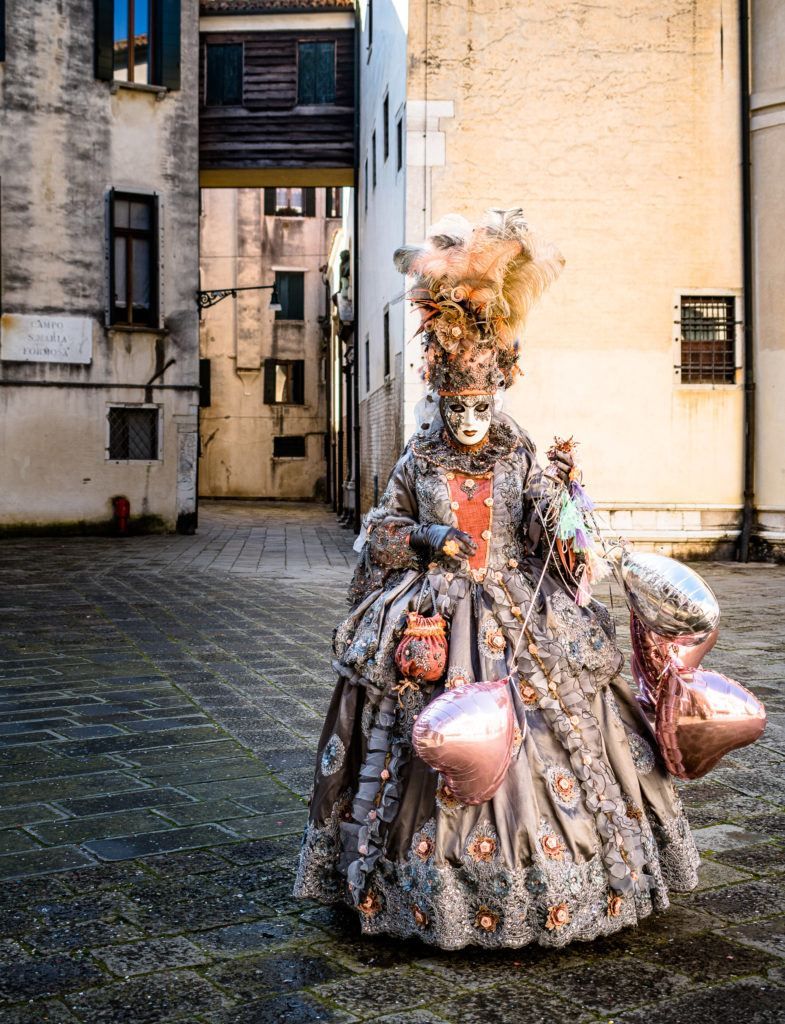
If you see someone in costume in the street, ask if you can take their photo. Most will happily oblige. This model was on her way to a photoshoot along a canal. Photograph by Jenn Mishra
Optimizing Group Photoshoots
At the height of Carnival, there will be dozens of photographers around each model. This isn’t a one-on-one studio setting. These group photoshoots have more in common with a paparazzi scrum. This photographic experience can be overwhelming at first, but there are ways of optimizing the situation.
It’s important to be respectful of the other photographers, but you’ll have to stand your ground as well. Look for the best light and angle to take the image. You may need to be patient and work your way into position. Wait your turn but stubbornly move forward.
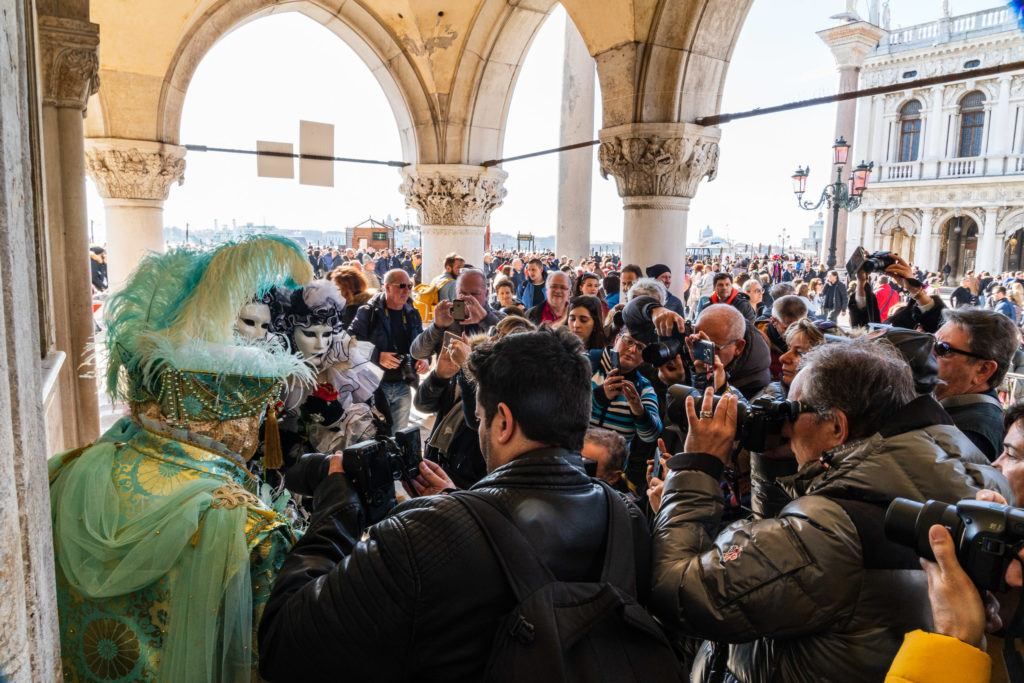
Photographing at Carnival can be challenging. There are often groups of photographers and tourists gathered around the costumed models. Photograph by Jenn Mishra
There are often many rows between photographers. The front photographers are low to the ground, and those behind lean over and photograph through the cracks. Photographers try not to step on each other, but it’s likely to happen. Most are polite and will try to rotate positions and give others a chance. Try not to be overly aggressive. You’re all after the same thing.
It’s important to be respectful of the other photographers, but you’ll have to stand your ground as well.
Experienced models will make eye contact with each photographer in turn. They seem to have infinite patience and try to give every photographer a chance for a good shot.
If the model is less experienced, call out politely but loudly and they will look your way. Try calling “Signor Maschera” (pronounced ‘mask-era’) or “Signora Maschera.” Maschera is Italian for “mask.” It’s a bit more polite and specific than, “Hey, you!”
Posing the Models
Experienced models will go through a series of stylized poses, but don’t be shy about asking the models to change position or move. Most will try to accommodate your request. Also, watch how the models interact with each other. If the models have worked together before, they may have poses worked out in advance.
The more experienced photographers know the models and have worked with them before. They will ask the models to move or adjust their positioning. If you are new to the scene, follow their lead to get the best poses and backgrounds.
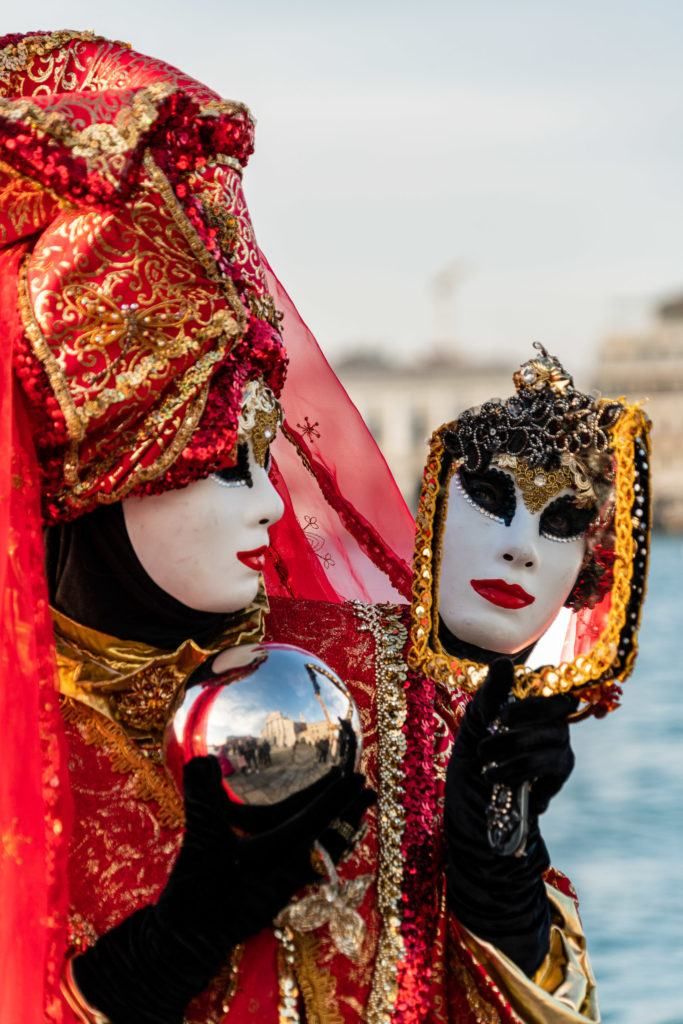
A favorite pose is to capture the mask in a handheld mirror. Experienced models know how to angle the mirror for the best photos. Photograph by Jenn Mishra
Carnival happens in the crowded, narrow streets of the city. Finding a clean background can be challenging. Look for positions that isolate the model from the crowd. Low angles allow you to use the tops of buildings or the sky as a background. Edges of canals or a bridge also eliminate much of the crowd, at least behind the model.
Experienced photographers know the city’s back streets. If you can, latch on to a small group and follow along. If it’s a private photoshoot, the photographer will let you know, but most will be welcoming.
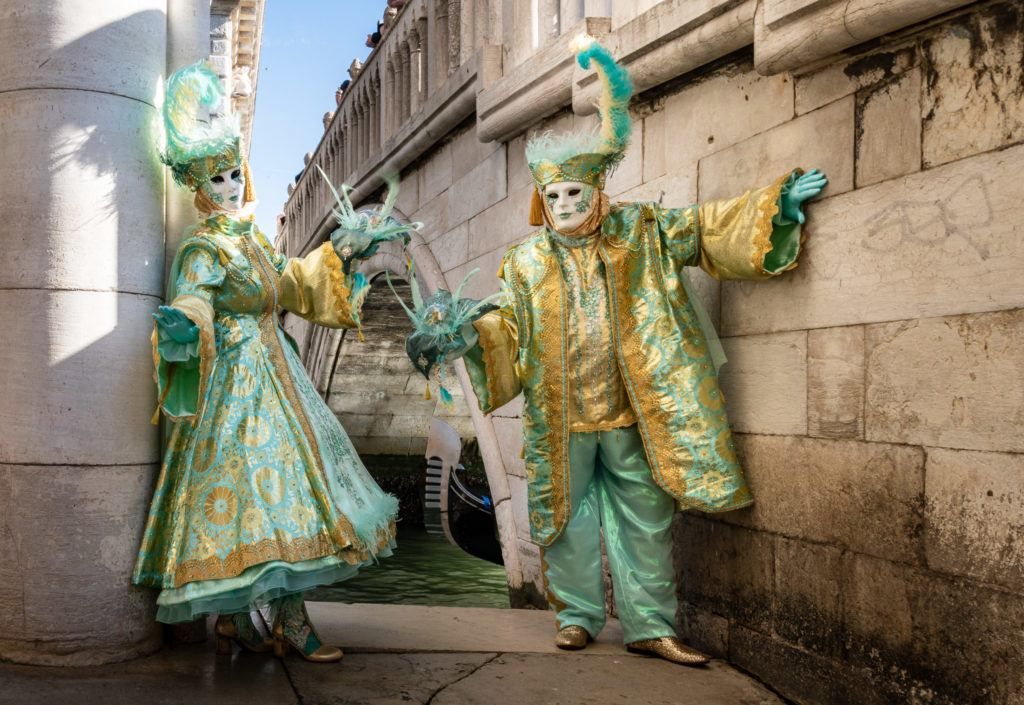
Working the angles near the Bridge of Sighs to minimize distractions in the background. To add a bit of context, I waited until a gondola peaked through under the bridge. Photograph by Jenn Mishra
Photographing Details and Context
Many of the elaborate costumes you see will be larger than life. It’s tempting to try and photograph everything all at once. By all means, take the full body shots. There is more than enough color and detail on these outfits to carry the image.
Every costume is a complete work of art. Every detail is thought through from the hats to the masks to the props carried by the models. Get the wide shots, but then shift your focus and explore the details. Get in close to the masked face or zoom in on a prop or the layers of textiles creating the costume. Focusing on the details will give you a greater appreciation for the craftsmanship.
With travel photography, it’s also important to include context. Place the models against iconic backgrounds or architectural details. Try to catch a canal or San Marco in the background or set the photoshoot against a distinctive church door.
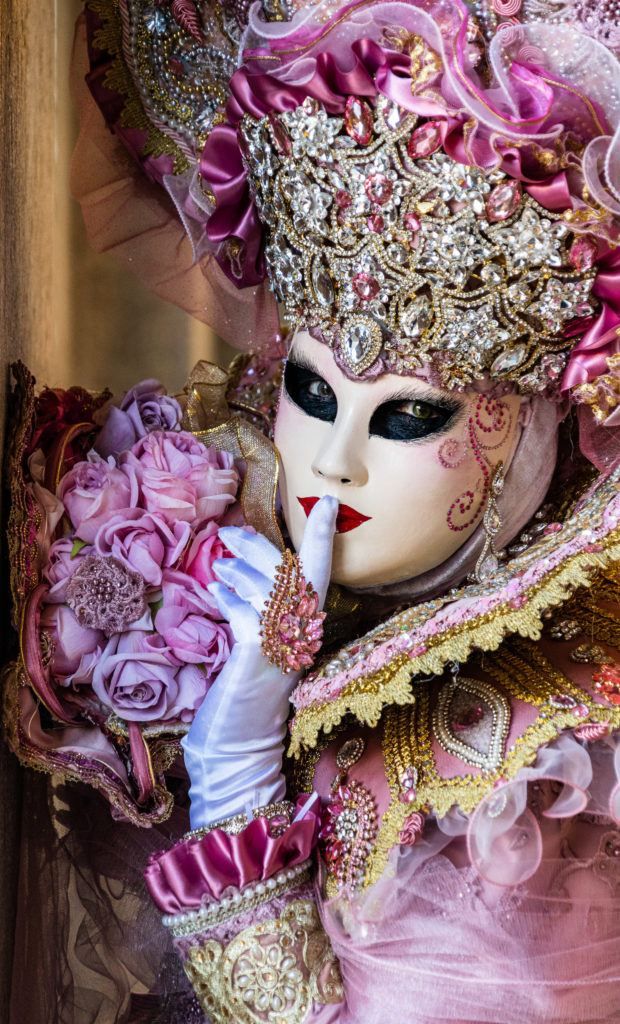
I got in close to photograph details in this costume worn by Solange. Focusing on details also allowed me to hide the tourists behind the model. Photograph by Jenn Mishra
Private Photoshoots
Many models are open to doing private photoshoots. If you’re new to the scene, you may need to pay the models for their time. You can hire a gondola and float down the canals with your models or arrange a meet-up at an iconic location. Note that some venues are only available for photoshoots if you get special permission or rent the space.
Another option is to schedule time with an experienced photographer. Many do group tours or individual photoshoots with models. You can sometimes pay to be a part of these shoots. You’re paying to learn from the expert, but you may also be paying for use of their lighting equipment and stylists.
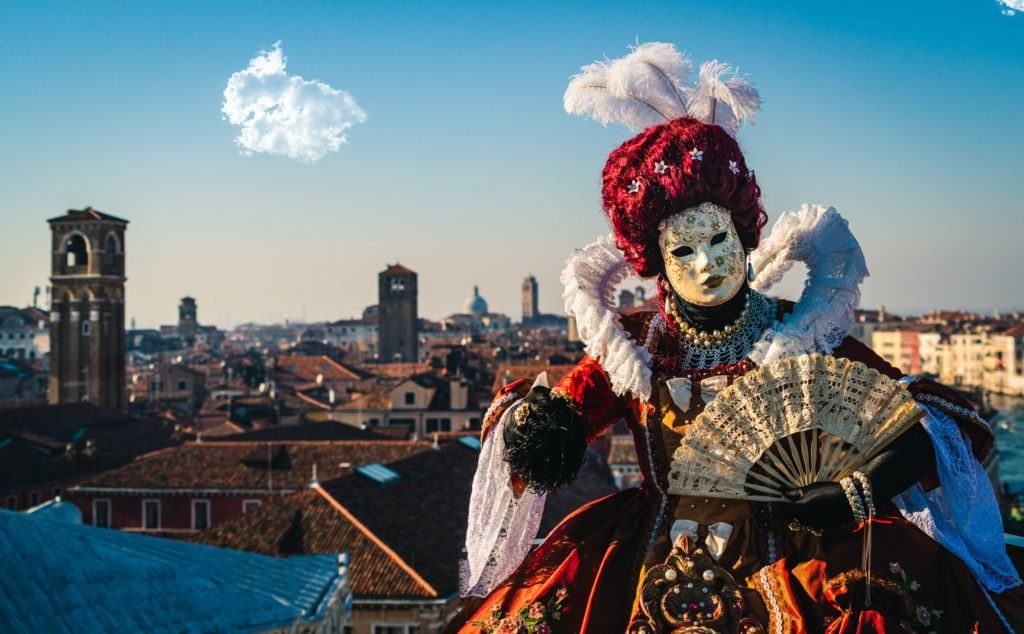
We needed special permission to shoot from the rooftop terrace of the T Fondaco dei Tedeschi department store by the Rialto Bridge. Photograph by Jenn Mishra
Camera Equipment
Let’s finish with a word about useful camera equipment for Carnival.
Many of the photographers carry two cameras or at least two lenses. There are times when you won’t be able to get close to a model because of other photographers or a crowd of tourists. A long zoom lens that’s good for portraits, like a 70-200mm, is useful. But other times you may be photographing in very close quarters. Narrow streets won’t give you a lot of space to work and passing tourists may constrain you further. In these situations, a wide-angle lens works better.
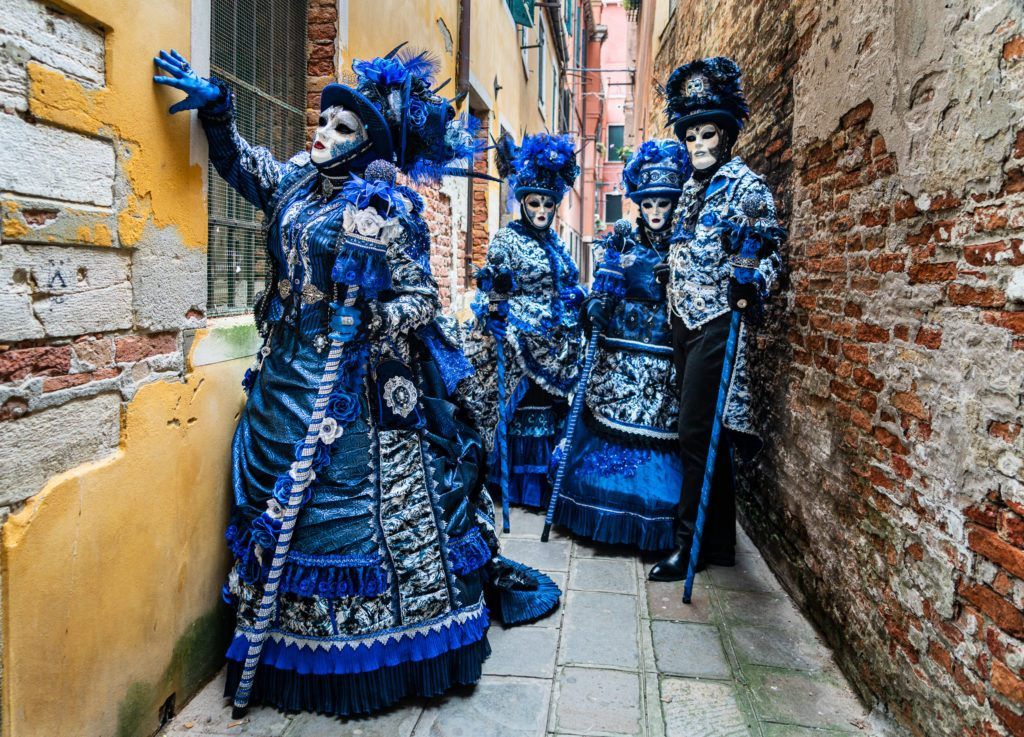
Shooting in narrow Venetian streets can be challenging. I used a focal length of 24mm to photograph this masked ensemble. Photograph by Jenn Mishra
Because the situations are changeable, you will need to be flexible, too.
Some photographers bring extra lighting equipment for use at dusk and dawn and in interior spaces.
Because the situations are changeable, you will need to be flexible, too.
You will need to decide how much equipment you can feasibly carry through the streets of Venice. Remember that the photoshoots are crowded. Light stands may be jostled or knocked over.
Keep your belongings close and be aware of your camera equipment. As with any crowded tourist attraction, there is the possibility of theft. Expensive cameras out in the open can be a magnet for thieves if you’re distracted.
Recommended Reading: If you’d like to learn how to create amazing portraits, grab a copy of Photzy’s premium guide: The Art of Portrait Photography.
Conclusion
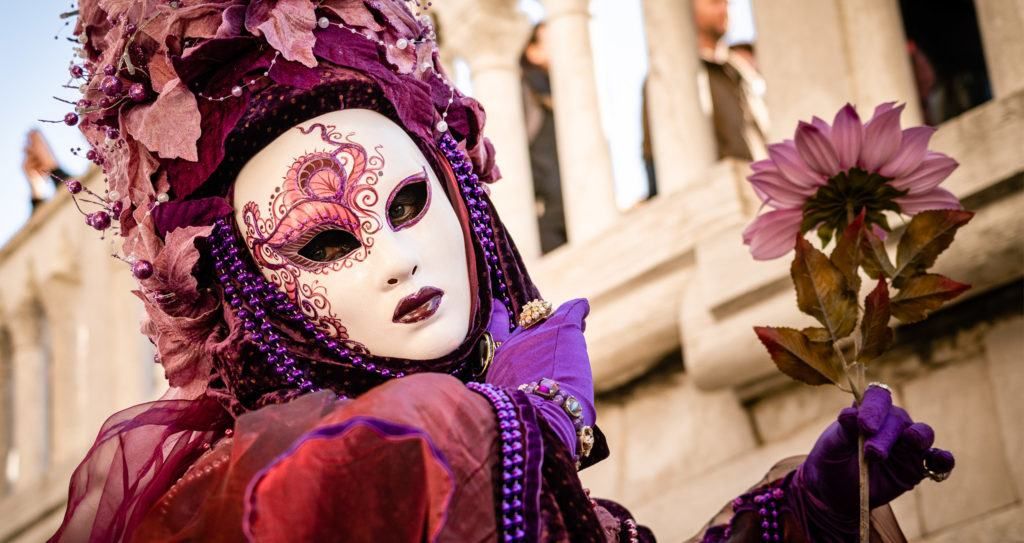
Photograph by Jenn Mishra
During Carnival, the entire city of Venice becomes a playground. People wearing elaborate masks and costumes float through the city. You can attend high-priced masked balls in historic venues or dance for free into the night in San Marco.
Carnival by and large has no entry fees, no costume requirements, and no special permission to photograph. Just show up and start photographing.
There’s a lot to photograph in Venice. It’s a good idea to plan to stay a few days after Carnival ends or before it gets too busy to focus on the city.
Self-Check Quiz:
- How is Venice’s Carnival scheduled each year?
- What event officially begins Carnival?
- What event takes place high above San Marco at the campanile?
- When might you pay a costumed model to pose for photographs?
- Where would you likely find costumed models to photograph in the evening?
- What phrase might you use to get the attention of a costumed model?
- How might you pose a model to eliminate a crowded background?
- What lenses are most useful during Carnival?
- Other than San Marco, where might you find costumed models?
- List three official activities organized for Carnival.

